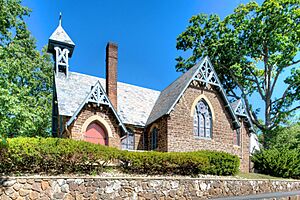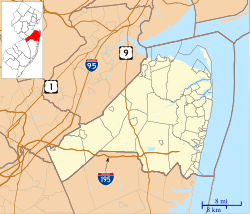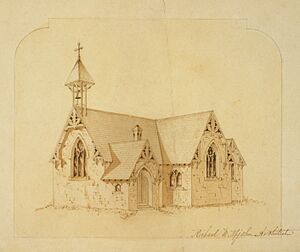All Saints' Memorial Church (Navesink, New Jersey) facts for kids
Quick facts for kids All Saints' Memorial Church |
|
|---|---|
| All Saints' Memorial Church in the Highlands of Navesink | |
 |
|
| 40°23′54″N 74°01′14″W / 40.39833°N 74.02056°W | |
| Location | Navesink, New Jersey |
| Country | United States |
| Denomination | Episcopal |
| History | |
| Status | Parish |
| Founded | 16 July 1864 |
| Founder(s) | John Henry Stevens |
| Architecture | |
| Functional status | Active |
| Architect(s) | Richard Upjohn |
| Architectural type | Mission parish |
| Style | Gothic Revival |
| Groundbreaking | October 7, 1863 |
| Completed | July 16, 1864 |
| Construction cost | approx. $3,000 |
| Specifications | |
| Materials | Uncoarsed fieldstone exterior, stained glass windows |
| Administration | |
| Episcopal area | Episcopal Church in the United States of America |
| Diocese | Episcopal Diocese of New Jersey |
| Province | Province II |
All Saints' Memorial Church is a beautiful stone church located in Navesink, New Jersey. It was built in 1864 by a famous architect named Richard Upjohn. The church and its surrounding buildings, like the rectory (where the priest lives) and the carriage house, are great examples of Upjohn's later work.
This special church complex was added to the National Register of Historic Places on February 15, 1974. This means it's an important historical building. Later, in 1987, it was named a National Historic Landmark, which is an even higher honor!
Contents
History of All Saints' Memorial Church
The All Saints' Memorial Church started as one of the first small churches built by English families. These families had settled in a place called Riceville, which is now known as Navesink, New Jersey.
How the Church Began
The idea for the church began with the family of John Henry Stevens, who came from the Isle of Wight. One of Stevens' daughters married Charles E. Milnor. Charles was a Philadelphia Quaker, but he was no longer part of his Quaker group because he married an Episcopalian.
Charles E. Milnor, John Henry Stevens, and their friends and family worked together. They formed a group to create the "All Saints' Memorial Church in the Highlands of Navesink." The official paper that started the church, called the certificate of incorporation, was signed on July 16, 1864. Charles E. Milnor was listed as a Warden, and E. M. Hartshorne was the Secretary.
Growth and Dedication
As more people joined the church, Charles Milnor started a school program. It quickly became very popular, with 70 children joining soon after it opened.
A very religious member named Mrs. James A. Edgar wanted to build a church. Sadly, she passed away too soon. So, her father and husband decided to build and support the church in her memory.
On October 7, 1863, the first stone of the church was laid. This special event was led by the Bishop of New Jersey, William Henry Odenheimer. Bishop Odenheimer, along with two other powerful Episcopalian bishops, often asked Richard Upjohn to design churches.
Adding More Buildings
When the church first opened in 1864, it had the main church building and a schoolhouse. Over time, All Saints' grew even more. They added three more buildings to the complex:
- A parish house in 1865.
- A rectory (the priest's home) in 1869.
- Carriage sheds around the year 1900.
Architectural Design and Style
The design of All Saints' Memorial Church is quite special. It looks a bit like another church called St. James-the-Less in Philadelphia. It's thought that Richard Upjohn was very impressed by St. James-the-Less when he saw it.
Gothic Revival Style
The influence of St. James-the-Less can be seen in many of Upjohn's smaller churches, including All Saints'. These churches are known for their simple, strong stone shapes without too much decoration. This style is called Gothic Revival architecture. Upjohn believed in "truth" in architecture, meaning buildings should be honest about their materials and purpose.
Upjohn was so respected that he was one of the people who started the American Institute of Architects. He also became its first President.
Why Gothic Revival Was Popular
Gothic Revival architecture was perfect for churches, especially for English parish churches. A professor of art history, William Pierson, explained why this style worked well in America. He said that small, stone churches fit much better into the American countryside than the plain, white buildings of other styles.
Also, groups like the New York Ecclesiological Society focused on practical things. They talked about using materials honestly, saving money, and making sure designs could be built by local workers. They also stressed simplicity, saying that a church didn't need to be fancy to serve its purpose.
This time in architecture was very strong and unified. It wasn't until the work of Henry Hobson Richardson much later that such a clear style would be seen again.
See also



